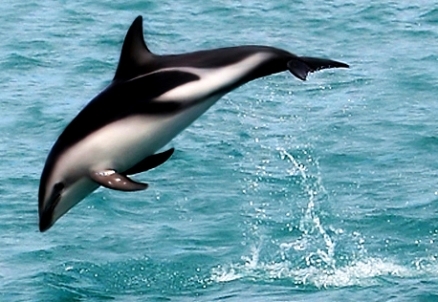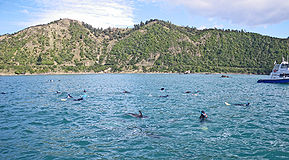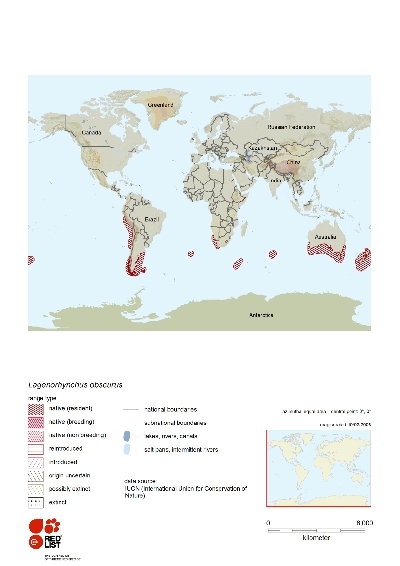Dusky dolphin
The Dusky dolphin is a medium-sized dolphin, which is easily recognised by the evenly sloping head from the blowhole to the tip of the snout, which lacks a beak. It is found in the Southern Hemisphere, near the coasts of South America, South Africa, the Kerguelen Islands, South Australia and New Zealand.
A marine mammal, the Dusky Dolphin is a member of the family of Oceanic Dolphins, part of the order of cetaceans.
As the common name suggests, the back and tail of this species are a dusky bluish-black, with a dark band running diagonally across the flanks to the tail. The underside is white and the tips of the snout and lower jaw are dark. A grey area runs from the eye to the flipper, and two cream stripes extend from the tail to the blunt dorsal fin.
The dusky dolphin ranges in length from 1.8 metres (m) to 2.0 m. It has virtually no beak, as the head slopes evenly down from the blowhole to the tip of the snout. The tip of the dorsal fin is rather blunt and is not markedly hooked.
A dusky dolphin has a bluish-black tail and back. A dark band runs diagonally across the flanks from below the dorsal fin towards the vent and along the tailstock. The underside of the body is white, and whitish-grey color extends over the flanks. The tips of the snout and lower jaw are dark. A grey area extends from the eye down to the flipper. Two diagonal whitish streaks run forward from tail up past the base of dorsal fin.
There are 24 to 36 pairs of small, pointed teeth about three millimetres in diameter in each jaw. The upper jaw ususally has two fewer teeth than the lower.
Contents
Reproduction
The mating pattern of these dolphins is promiscuous, adult males competing for mating access to females. Pair bonds do not appear to be formed, but social cohesion within the school is strong. Mating of dusky dolphins usually takes place during spring.
Gestation lasts for 11 months, and the peak months of birth for dusky dolphins are June to August. Dusky dolphins produce one young per birth; the weight of the young is about five kilograms. The lactation period lasts for 18 months. There is no information on the sexual maturity and the life span of dusky dolphins.
Behavior
Dusky dolphins are often seen in groups of six to fifteen, occasionally up to 300 for feeding aggregations. Groups are typically of mixed ages and include members of both sexes. Groups are usually stable for at least several days.
Dusky dolphins are among the most altruistic of the dolphins. They have been reported to assist other dolphin species in distress, and to aid humans.
They spend night-time in small schools of six to fifteen animals no more than a kilometre (km) offshore. During this period, dusky dolphins are at rest with only slow movements. In the morning, they move into deeper water, about two to ten km from shore. At this time, they search for food in groups, swimming in a line abreast with each animal approximately ten metres from the next. Then they may aggregate up to 300 individuals for cooperative herding. By mid-afternoon, feeding may be concentrated in one area, and dusky dolphins start to interact socially in play and sexual activity. In the evening, the large school of dusky dolphins splits up into smaller groups and returns inshore.
Dusky dolphins are extremely fond of playing and leaping; they often leap in schools. The species is especially attracted to boats. They are fleet swimmers, attaining speeds up to 20 knots.
Dusky dolphins produce a variety of whistles, squeaks, squeals and clicks. These sounds are loud and directional (Dawson. 1985). The sound of a dusky dolphin reentering the water after a leap carries at least 500 m but less than one km underwater. In air, the sound can be heard as far away as three km distant. Dusky dolphins often leap before and after feeding. The leap has been hypothesized to function to recruit other dolphins to feeding activities
These dolphins were thought to be very abundant, but declining numbers in by-catch and during hunting suggest that dusky dolphins are no longer as plentiful as earlier imagined. The larger aggregations are temporary collections of the more characteristic sized pods, gathering together for tactical hunting of their anchovy, squid and shrimp prey. The prey are herded together by groups of cooperating dolphins, who leap and slam their bodies on the surface of the water to push the prey closer together as well as to notify other dolphins to join the feeding.
Said to be one of the most acrobatic and social of all dolphins, the dusky dolphin is attracted to boats to bow-ride at speeds of up to 20 knots, and will spend afternoons playing, leaping, and mating. They communicate regularly with whistles, squeaks and clicks.
Mating occurs in spring, and is somewhat promiscuous within each school, but no pair bonds are formed. Gestation lasts up to 11 months and single calves are born between June and August. Calves measure less than 60 cm and are weaned at 18 months. Females give birth every two to three years.
Distribution
Dusky dolphins have a circumpolar distribution in the Southern Hemisphere. They can be found near the coasts of South America, South Africa, the Kerguelen Islands, South Australia and New Zealand.
Whilst found almost everywhere in the southern hemisphere, particularly high concentrations of dusky dolphins are found around New Zealand, Tasmania, southern Australia and south-western Africa. Populations are also found around the western coast of South America, but appear to be separated both geographically and biologically by a gap spanning 1000 km of Chilean coastline. Individuals to the north of this separation are typically larger than those to the south, and are sometimes considered a separate subspecies.
Habitat
The Dusky dolphin occupies warm to cool temperate waters and coastal regions and over continental shelf and slope.
Food habits
The main prey species of dusky dolphins include anchovy (the southern form), squid and schooling shrimps. Dusky dolphins feed both at bottom and at the surface. They generally feed with cooperative herding of large schools of small fish by aggregations of up to 300 dolphins.
Conservation status
The Dusky dolphin is catalogued on the IUCN Red list as Data Deficient.
Threats and human interactions
The taking of all small cetaceans is prohibited, but the demand is sufficiently high that this ban is poorly enforced and therefore ineffective.
The extent of the threats to this species is not fully understood, but major losses are recorded as a result of gill net entanglement and illegal harpooning. Dolphin meat is in demand in Peru and blubber is used as shark bait.
Large catches off western South America have caused serious concern. Thousands of dusky dolphins are killed annaually by the small-cetacean fishery in Peru. Although in 1990 the Peruvian government banned the direct fishery for small cetaceans, the ban has not been effective.
The fresh meat of dusky dolphins is sold in the markets of Lima for slightly above $1.00 US per kg, with approximately 10,000 individuals being killed each year.
The Dusky dolphin is of interest to tourists. For instance, at Kaikoura, South Island, New Zealand, an intensive dolphin-watching industry is centered on taking tourists to see and to swim with these animals.
Further reading
- Yu, H. 1999. Lagenorhynchus obscurus, Animal Diversity Web, University of Michigan
- Hammond, P.S., Bearzi, G., Bjørge, A., Forney, K., Karczmarski, L., Kasuya, T., Perrin, W.F., Scott, M.D., Wang, J.Y., Wells, R.S. & Wilson, B. 2008. Lagenorhynchus obscurus, IUCN Red List of Threatened Species. Version 2009.1. accessed May 16, 2010
- Doak, W. 1985. Dolphin Dolphin. New York, NY: Sheridan House. ISBN: 091137843X.
- Encyclopedia of Life Lagenorhynchus obscurus accessed May 16, 2010
- Heyning, J. 1995. Whales, Dolphins, Porpoises: Masters of the Ocean Realm. Seattle, WA: University of Washington Press. ISBN: 0295974877.
- Thomas A. Jefferson, Marc A. Webber, Robert Pitman and Brett Jarrett, 2007. Marine Mammals of the World Academic Press ISBN: 0123838533.
- Ridgway, S., S. Harrison. 1994. Handbook of Marine Mammals, Volume 5: The First Book of Dolphins. San Diego, CA: Academic Press Inc. ASIN:B000J38O38
- Baker, A.N. 1990. Whales & Dolphins of New Zealand & Australia. Victoria University Press, Wellington. ISBN: 0864730993.
- Dawson, S. 1985. The New Zealand Whale & Dolphin Digest. Brick Row Publishing Company Limited, Hong Kong.ASIN: B0006EMB2A
- Evans, P.G. 1987. The Natural History of Whales & Dolphins. Facts on File Publications, New York. ISBN: 0816017328.
- Grzimek, B. 1975. Grzimek's Animal Life Encyclopedia. Van Nostrand Reinhold Company, New York. ISBN: 0787653624.
- Herman, L.M. 1980. Cetacean Behavior: Mechanisms and Functions. John Wiley & Sons, New York. ISBN: 0894642723.
- New Zealand Whale & Dolphin Trust accessed May 16, 2010
- Nowak, R. M.2003. Walker's Marine Mammals of the World. The Johns Hopkins University Press, Baltimore. ISBN: 0801873436.
- IUCN Red List (May, 2009) http://www.iucnredlist.org
- Convention on Migratory Species: Lagenorhynchus obscurus (May, 2009)
- Jefferson, T.A., Leatherwood, S. and Webber, M.A. (1993) FAO Species Identification Guide. Marine Mammals of the World. FAO, Rome.
- CITES (November, 2004) http://www.cites.org
- Waterhouse, G.R. and Darwin, C.R. (1839) Mammalia Part 2 of The Zoology of the Voyage of H.M.S. Beagle. Smith Elder and Co., London.
- Martin, A.R. (1990) Whales and Dolphins. Salamander Books, London.
- Gordon, D. (Ed.) (2009). New Zealand Inventory of Biodiversity. Volume One: Kingdom Animalia. 584 pp
- IUCN (2008) Cetacean update of the 2008 IUCN Red List of Threatened Species.
- Mead, James G., and Robert L. Brownell, Jr. / Wilson, Don E., and DeeAnn M. Reeder, eds. 2005. Order Cetacea. Mammal Species of the World: A Taxonomic and Geographic Reference, 3rd ed., vol. 1. 723-743
- New Zealand Whale & Dolphin Trust. http://ralenti.co.nz/topics/nzwhale.html
- Nowak, R. M.1991. Walker's Mammals of the World. Fifth Edition. The Jonhs Hopkins University Prsss, Baltimore.
- Perrin, W. (2010). Lagenorhynchus obscurus (Gray, 1828). In: Perrin, W.F. World Cetacea Database. Accessed through: Perrin, W.F. World Cetacea Database at http://www.marinespecies.org/cetacea/aphia.php?p=taxdetails&id=231434 on 2011-02-05
- Reeves, R and S. Leatherwood. 1994. Dolphins, Porpoises, and Whales. International Union for Conservation of Nature and Natural Resources, Switzerland.
- Rice, Dale W. 1998. Marine Mammals of the World: Systematics and Distribution. Special Publications of the Society for Marine Mammals, no. 4. ix + 231
- UNESCO-IOC Register of Marine Organisms
- Wilson, Don E., and DeeAnn M. Reeder, eds. 1993. Mammal Species of the World: A Taxonomic and Geographic Reference, 2nd ed., 3rd printing. xviii + 1207
- Wilson, Don E., and F. Russell Cole. 2000. Common Names of Mammals of the World. xiv + 204




